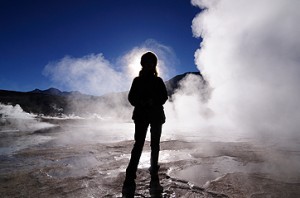Energy Efficiency
Geothermal energy is an often overlooked and misunderstood renewable energy source.
Geothermal energy is an often overlooked and misunderstood renewable energy source.
Geothermal energy has been around since the formation of the earth, yet this free and renewable energy is often overlooked and misunderstood. This abundant source of heat is continuously produced within the Earth’s core, thus recovering this hot water or steam can be used to heat buildings or generate electricity. Here we will explore geothermal energy facts and provide an understanding on how this energy source can aid in our bid for energy independence.
 The term geothermal derives from the Greek words for earth (geo) and heat (therme), thus geothermal energy is the heat within the Earth. Decay of radioactive particles deep within the core of the Earth produces temperatures hotter than the surface of the sun, continuously. Rocks and water absorb this heat, which can be harnessed by drilling wells. These wells bring the superheated water or steam to the surface which can be used to heat homes or buildings and to power turbines creating electricity.
The term geothermal derives from the Greek words for earth (geo) and heat (therme), thus geothermal energy is the heat within the Earth. Decay of radioactive particles deep within the core of the Earth produces temperatures hotter than the surface of the sun, continuously. Rocks and water absorb this heat, which can be harnessed by drilling wells. These wells bring the superheated water or steam to the surface which can be used to heat homes or buildings and to power turbines creating electricity.
Since the earliest known records, humans have used geothermal water or hot springs for warmth and pleasure. From the simple acts of just soaking in the warm water, to the ancient Romans using it to treat eye infections and heat of buildings, geothermal energy is timeless. It was only in recent times, the past few hundred years or so, that we learned how to actually harness this energy for power production. This is where modern geothermal power plants come in.
Today, less than 10 percent of the world’s energy is produced from geothermal energy production methods. While governmental surveys have found that the geothermal energy resources base is larger than the combined resource base of oil, coal, natural gas and nuclear elements – it still struggles to become mainstream. This is partly due to geography, rather than a misunderstanding of the resource. Areas with significant geological activity, such as volcanoes and earthquakes are most suitable for extracting the geothermal energy.
Once a suitable location is found, it is up to the geologists, geochemists and engineers to drill deep into the Earth in order to access the geothermal reservoir of superheated water. The drilling will create geothermal production wells and injections wells to pipe the water and steam into the power plant and return it once fully utilized.
The heated water or steam pumped into a geothermal power plant is used to spin a turbine, creating electricity, similar to tidal power or hydroelectric energy sources. Since the water is returned to the geothermal reservoir to be used again, the process is considered fully renewable.
The type of geothermal plant used to generate electricity is based on the temperature and pressure of the geothermal reservoir that is being used. There are three different kinds of geothermal power plants, flash power plants, binary power plants and dry steam power plants. Below we will clarify the differences of each type of plant, helping you understand these geothermal power facts.
While geothermal energy will not be the only solution needed for a true sustainable earth, it is part of the overall puzzle. Embracing this energy source where geologically possible can lead to less dependence on coal-fired power plants, thus reducing our collective carbon footprint.